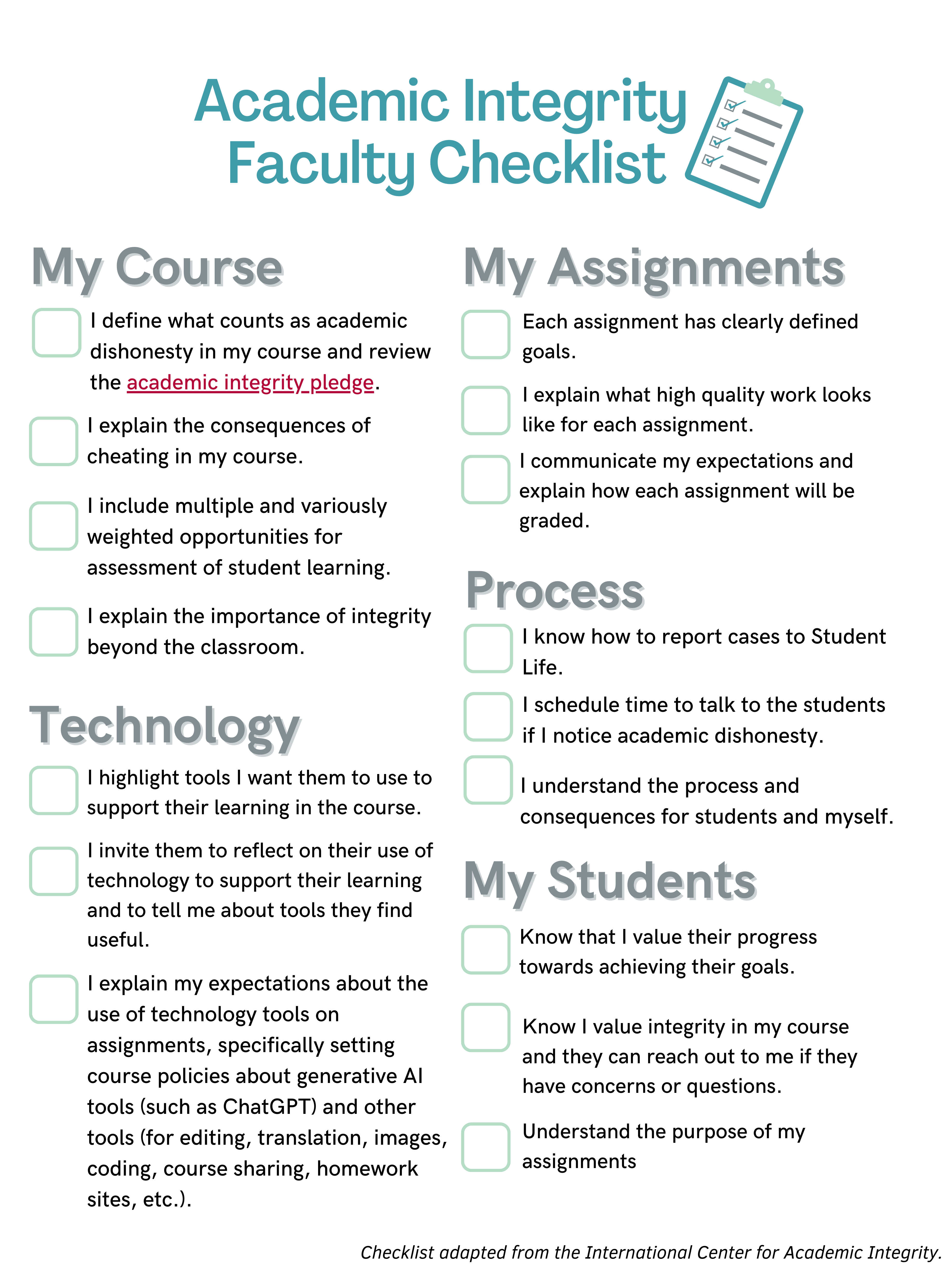We often assume that students come to class knowing what academic integrity is; however, students don’t always know what constitutes academic dishonesty, and faculty across the disciplines may define it somewhat differently. In order to address this issue, research recommends that faculty talk about academic integrity with their students.

Download the Academic Integrity Checklist PDF (includes a link to the pledge).
Teaching Strategies
Faculty need to help students understand how academic integrity applies to their particular course. But what does that look like?
1. Creating a Classroom Community
Focus on building and strengthening the classroom community. Faculty can support student learning by creating safe spaces for students to take risks, ask questions, and explore the course content in a meaningful way. In the early days of your course, review your expectations of learning and share ways students can help themselves and each other succeed. It can also make a real difference to highlight your commitment to student wellness. Academic integrity issues often result from students feeling stressed, overwhelmed, unmotivated, and stuck. A strong classroom community can help mitigate some of those issues as students share their struggles, find peer and university support, and talk to their instructor. The bottom line is to create a learner-oriented environment.
2. Teachable Moments: Proactive Approaches
Changing mindsets can help all of us reframe academic integrity. Rather than focusing on the punitive aspects, consider how teaching academic integrity can support students’ intellectual, ethical, and professional development. Include a short presentation on how to properly cite and document references. Emphasize the resources and peer support available at the HUB Writing Center and other university services such as the Drahmann Center and the Wellness Center. Although many of these resources may be listed in the syllabus, talking about this in class a couple of times over the course of the quarter can help students find help early, and can normalize asking for support. It is important to think about how to highlight trust and honesty, fairness, and responsibility to learning.
More importantly, find time to talk to students about your expectations throughout the course. Syllabus statements should be revisited at key moments in your teaching (such as when you are reviewing assignments and grading practices). As technology tools continue to emerge and change, having conversations about what is acceptable and what is not is crucial for students. If you're looking for more information and strategies about academic integrity and generative AI, visit our other DRT resource here.
3. Agency and Choice
Students appreciate choice in how to demonstrate their learning. Research notes that providing students with options for what assignments they would like to complete helps ensure that the coursework aligns with the students’ interests, learning goals, and future professional lives. While having a variety of assignments may not be feasible for faculty, it is important to consider how the course and the assignments fit in the students’ lives. Another way to create opportunities for agency and choice is to consider a different grading approach. Some faculty use a labor-based grading approach to increase equity and access. Such an approach might invite students figure out what assignments they can complete and which learning goals they can accomplish given their own commitments and goals. Another alternative to consider is giving students opportunities to revise or retake assignments and assessments to improve their grades. This helps the student focus on learning through an iterative process rather than on perfection or failure.
References and Additional Resources
For more resources about academic integrity, visit SCU Library's LibGuide.
Ajjawi, R., Boud, D., Jorre de St Jorre, T., & Tai, J. (2022). Assessment for inclusion in higher education. Routledge.
Eaton, S. E., & Christensen Hughes, J. (2022). Academic integrity in Canada: an enduring and essential challenge. Springer.
International Center for Academic Integrity. (2022). Academic integrity checklist.
Ohio State University – Teaching and Learning Resource Center. A Positive Approach to Academic Integrity.
Page author: Lisa Chang, PhD, Faculty Development
Last updated: July 31, 2023